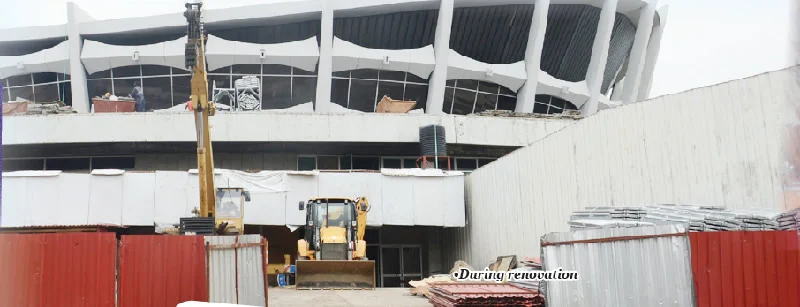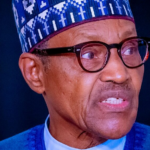In 1978, the future held bountiful hopes for Nigeria’s cultural monument and arguably home of entertainment; National Theatre. It was a year after the monument located in Iganmu, Lagos, hosted the remarkable Festival of Arts and Culture in 1977 between January 15 and February 12, otherwise called FESTAC ’77. The event drew participants from 56 African countries and beyond who exhibited art, music, song, literature and other artistic expressions. The edifice was completed in 1976.
Accounts regarding the iconic National Theatre have been documented in publications which included The National Theatre: The Sleeping Monument, by Claude Opara, The Nigerian National Theatre At Iganmu: the Legacy of A Festival, A Challenge to the Future, by Dr Ahmed Yerima, Architecture in Global Socialism, by Lukasz Stanek, and The Cold War from the Margins–A small socialist state on the global cultural scene by Theodora K. Dragostinova.
Several accounts narrated that in 1966, after her star performance at the first edition of the World Black and African Festival of Arts and Culture, Nigeria was selected to host the second edition.
They indicated that the Yakubu Gowon government wanted to build a befitting structure as the main venue, so it set up a team, led by the late Chief Anthony Enahoro, the then Federal Commissioner for Information.
The team was said to have visited Europe and the United States to look around and get ideas. In 1972, the delegation was said to have visited Bulgaria, and was highly impressed by the Palace of Sports and Culture (completed in 1968) in Varna, a coastal city like Lagos, and decided to build a similar structure in Nigeria.
The accounts indicated thus, “A swampy area in Iganmu, Surulere, Lagos, the nation’s capital then, was chosen as the location because Iganmu was almost of equal distance between Victoria Island and Lagos Mainland.
“On April 24, 1973, the government signed the contract to build the National Theatre. The main building contractor was a Bulgarian company called TechnoExportStroy, one of whose board members was a Nigerian, Sule Katagum.
“This company also built Eko Hotel in 1977, Bauchi Hotel in 1983, and some other well-known buildings in Nigeria. The chief architect was Stefan Kolchev, the same person who designed the Palace of Sports and Culture in Varna, Bulgaria. Because of the marshy soil in the location chosen for the National Theatre, 400 piles were laid for the foundation.’’
They disclosed that the company completed the building and handed it over to the Nigerian government on July 5, 1975.
“It was opened on September 30, 1976, by General (Olusegun) Obasanjo, who was then Nigeria’s Head of State. Five months later, from January 15 to February 12, 1977, it hosted The Second World Black and African Festival of Arts and Culture,’’ the accounts read.
On the similarities and differences between the Bulgarian structure and the National Theatre, it was gathered that the National Theatre in Lagos was four times bigger than the Palace of Sports and Culture in Varna, covering 23,000 square meters. Also, it’s said to be taller, rising seven storeys, more than 31 meters into the sky, compared to 15 meters of the one in Bulgaria.
They explained further, “However, the two buildings are reinforced concrete structures and share a similar design: both are shaped like a saddle. Because the Nigerian Coat of Arms above the main entrance of the building in Lagos makes it look like the peaked cap worn by Nigeria’s military leaders like Gowon and Murtala Muhammed, Nigerians called the design “General’s Cap” or “Fila Gowon”(after General Yakubu Gowon, the head of state when the building was completed in 1975. He was overthrown two weeks later, on July 29, 1975), and later “Fila Murtala” (after General Murtala Muhammed, who took over from Gowon).’’
The rot
But decades later, the monument witnessed noticeable deterioration with efforts by stakeholders to ensure its overhaul. Many art experts and enthusiasts have consistently noted that mismanagement, lack of maintenance and underfunding robbed the theatre of its shine and prestige. The interest culture advocates had for the centre waned considerably as cracks, leaky roofs and outages dejectedly became trademarks of the once famed edifice.
After several years of examining several options to revive the theatre, the Federal Government in 2021 handed over the renovation of the edifice to the Central Bank of Nigeria to the tune of N21bn.
The revival
On February 14, 2021, stakeholders met in Lagos on the project for the signing of the Memorandum of Understanding between the Bankers’ Committee and the Ministry of Information of Culture on the investment plan to revive the National Theatre and build a new creative city at Iganmu.
The Governor of the CBN, Godwin Emefiele, said the project would generate about 25,000 jobs upon completion and create 10,000 direct and indirect jobs during the construction.
He noted that for the National Theatre to retain its ambience, the Ministry of Information and the Bankers Committee would ensure its management by a top-notch facility manager appointed through skilled consultants.
Mufu Onifade, a visual artist and former Chairman, National Association of Nigerian Theatre Arts Practitioners, Lagos chapter, said he had beautiful memories of the National Theatre beginning in 1982 when, as students, they were led by their art teacher to witness the permanent art exhibition of the National Gallery of Modern Art.
He stated that as an actor, taking part in a play on the National Theatre stage was akin to a footballer playing in the National Stadium, adding that such experience was the height of professionalism.
“The National Theatre remained our best cultural edifice from 1977 until 1989/1990 when it began to deteriorate. As of 2005, it had become so bad that many artists stopped staging their shows there. They started opting for alternative performance spaces.
Race to host first Global Conference on Cultural Tourism and Creative Industry
The Minister of Information and Culture, Lai Mohammed, disclosed this recently in Madrid, Spain while signing an agreement on Nigeria’s hosting of the first Global Conference on Cultural Tourism and Creative Industry.
Nigeria signed the bilateral agreement with the United Nations World Tourism Organisation (UNWTO) at the organisation’s headquarters.
Mr Mohammed said the global conference, which would hold from November 14 to 17, would be the first event to be staged at the newly refurbished edifice.
“With that, the National Theatre is now known as the Lagos Creative and Entertainment Centre.
Delighted with ongoing work at the National Theatre, its current General Manager, Prof. Sunday Ododo, said a week after assumption of office, he led his team to tour facilities in the edifice for six hours, disclosing that he wept after the exercise over its dilapidated state.
Ododo said: “I assumed office on September 1, 2020. Barely a week after assumption of office, I did a comprehensive tour of the internal facilities in the edifice. We started at 8am and it took us 2pm to come out of the edifice. I wept because it’s an edifice; a bowel of riches but underutilised because of failing functionality of the installed facilities. The air conditioners were no longer functional and the lifting system no longer working. One could see visible cracks on the floor and the cooling system not working. The general aura of the space was not conducive and attractive. The essence of an event facility is to give one comfort and an unusual ambience of congeniality that prepares one to get ready to partake in an event.’’
The professor of Performance Aesthetics and Theatre Technology said: “We will invite artists back to have a feel of a world-class event centre and cultural zone. Soon, work will be on the entertainment hub opposite the centre for IT, music, fashion and film to complement the new edifice.
“These four verticals would give the youth ample opportunity to hone their talents in IT, music, fashion and film. You will agree with me that these appeal more to our youths’ ingenuity. Nigerian youths are creative. Look at the waves they are making in music and in Nollywood. I tell you that their ingenuity will become top-notch in IT. In a few years, we will get Nigerian youths who will come up with applications and solution-oriented software that will compete well anywhere.
“We encourage the creative industry and culture workers to get ready because the sky will be the beginning. There is much to do. They should lace their creative boots and get ready to explore.’’
Both the minister of information and culture and the CBN governor echoed during an inspection tour of work done so far at the facility that it would be completed and inaugurated by November. The CBN governor expressed satisfaction that the project estimated to cost the banking sector about $100m was also attracting foreign investors.

 Join Daily Trust WhatsApp Community For Quick Access To News and Happenings Around You.
Join Daily Trust WhatsApp Community For Quick Access To News and Happenings Around You.


